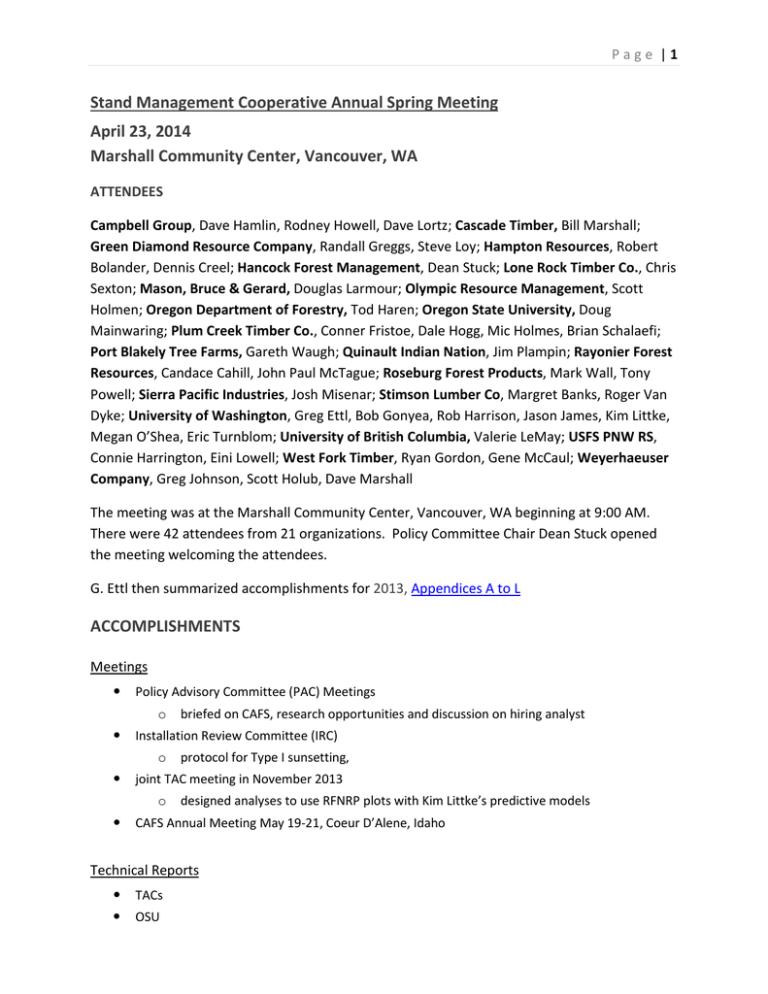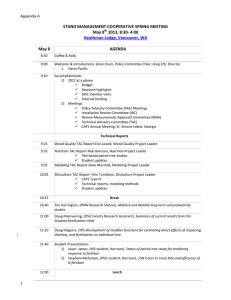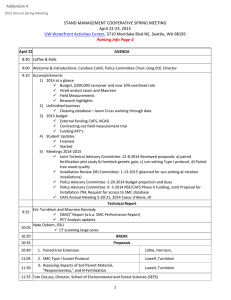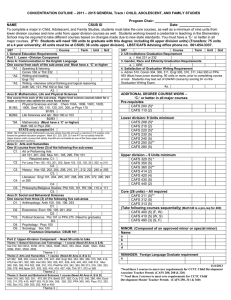April 23, 2014 Marshall Community Center, Vancouver, WA
advertisement

Page |1 Stand Management Cooperative Annual Spring Meeting April 23, 2014 Marshall Community Center, Vancouver, WA ATTENDEES Campbell Group, Dave Hamlin, Rodney Howell, Dave Lortz; Cascade Timber, Bill Marshall; Green Diamond Resource Company, Randall Greggs, Steve Loy; Hampton Resources, Robert Bolander, Dennis Creel; Hancock Forest Management, Dean Stuck; Lone Rock Timber Co., Chris Sexton; Mason, Bruce & Gerard, Douglas Larmour; Olympic Resource Management, Scott Holmen; Oregon Department of Forestry, Tod Haren; Oregon State University, Doug Mainwaring; Plum Creek Timber Co., Conner Fristoe, Dale Hogg, Mic Holmes, Brian Schalaefi; Port Blakely Tree Farms, Gareth Waugh; Quinault Indian Nation, Jim Plampin; Rayonier Forest Resources, Candace Cahill, John Paul McTague; Roseburg Forest Products, Mark Wall, Tony Powell; Sierra Pacific Industries, Josh Misenar; Stimson Lumber Co, Margret Banks, Roger Van Dyke; University of Washington, Greg Ettl, Bob Gonyea, Rob Harrison, Jason James, Kim Littke, Megan O’Shea, Eric Turnblom; University of British Columbia, Valerie LeMay; USFS PNW RS, Connie Harrington, Eini Lowell; West Fork Timber, Ryan Gordon, Gene McCaul; Weyerhaeuser Company, Greg Johnson, Scott Holub, Dave Marshall The meeting was at the Marshall Community Center, Vancouver, WA beginning at 9:00 AM. There were 42 attendees from 21 organizations. Policy Committee Chair Dean Stuck opened the meeting welcoming the attendees. G. Ettl then summarized accomplishments for 2013, Appendices A to L ACCOMPLISHMENTS Meetings Policy Advisory Committee (PAC) Meetings o Installation Review Committee (IRC) o protocol for Type I sunsetting, joint TAC meeting in November 2013 o briefed on CAFS, research opportunities and discussion on hiring analyst designed analyses to use RFNRP plots with Kim Littke’s predictive models CAFS Annual Meeting May 19-21, Coeur D’Alene, Idaho Technical Reports TACs OSU Page |2 PNW Research Station UW graduate students Budget carried over $54,229 (~8% of budget) 10% increase in dues increases revenue, but… ODF dues won’t increase until 2015 WADNR back to 100% but no 10% increase until 2015 budget available for hiring an analyst Field Work Field work nearly completed for 2013-2014 measuring season, data will likely be available for distribution mid-July, Type I’s o 8 full measurements o 19 RD checks o 5 plots marked for thinning Type III’s o 8 full Measurements o 1 plot measured and marked for thinning Type IV’s o 3 full Measurements Type V’s o 34 full Measurements o 73 weather stations data collected and maintained o 18 weather stations dismantled we initiated funding for Eric’s PCT analysis in fall 2013 (underway) Kim Littke working as a Post-doctoral Research Associate for Rob Harrison update on fate of labeled 15N study (NSF/CAFS) deep soil carbon and forest production update on Silvicultural Manipulations Consequences at SMC Sites progress on genetic gain trial (Type IV) study TECHNICAL REPORTS WOOD QUALITY TAC REPORT: Eini Lowell Eini presented a measurement protocol for Sunsetting Type I Installations and a new CAFS proposal to augment Type V wood quality sampling. Members voiced concern for the lack of Page |3 funding going towards wood quality research and questioned the impetus for Eini to continue submitting RFP’s, Greg said it wasn’t an issue of not wanting to fund the research but rather prioritizing funds towards what members express as their top priority-1) cleaning up the database and 2) hiring an analyst. NUTRITION TAC REPORT: Rob Harrison Rob and his graduate students presented updates on the following 4 projects; 1) Paired Tree Study, (Kim Littke, Post Doc, afternoon presentation, 2) 15N Research, (Stephani MichelsenCorrea, PhD), 3) Deep Soils Project, (Jason James, MS, afternoon presentation), and 4) Fall River/ New LTSP studies, (Marcella Menegale, MS). 1. Paired-Tree & Paired/Plot studies – Kim Littke 2. 15N – Stephani Michelsen-Correa Milestones: 1) Establishment of 10 installations in PNW, 9 in the Midwest and 21 in the South completed over a two-year period. 2) Completed of sampling for installations established in 2011. 3) Beginning sampling of installations installed in 2012. 4) Purchase of Isotope Ratio Mass Spectrophotometer at Virginia Tech for 15N analysis. 5) Sample analysis of tree, understory vegetation, forest floor and soil samples for 15N is in progress. 6) Graduate student theses and publications are being prepared. Expected Deliverables: The project will provide the members of CAFS with data on the N uptake efficiency following fertilization with conventional urea and how that can be improved if enhanced efficiency fertilizers are used instead of urea. The study will also provide information on the environmental fate of the applied urea, including losses from volatilization, which is needed to demonstrate that forest fertilization is an environmentally sound forestry practice. The amount of nitrogen lost below the rooting zone via leaching will be accounted for. This will aid CAFS members in determining the environmental fate of applied fertilizer and the potential for off-site environmental movement of nitrogen following fertilization. 3. Deep soils – Jason James effective soil depth one of the important predictors of productivity Douglas-fir maximum rooting depths can be over 3 meters C & N interact with cation cycles through leaching significant under-estimation based upon shallow sampling. Other nutrients may be necessary for fertilization & management Page |4 Timeline & Milestones manuscript on deep soil carbon published in Soil Science Society of America Journal, North American Forest Soils Conference Proceedings deep soil nitrogen manuscript will be submitted summer 2014 new deep soil sampling pits – Summer 2014 manuscript on base cation cycling in preparation 4. Fall River/ New LTSP studies, Marcella Menegale Study Objectives: Look at the fate of the influence of organic matter removal during timber harvest – how does the presence/absence of harvest debris (such as chips, branches) in the area influences the accumulation of nutrients in the soil and, consequently, the final productivity of Douglas-fir forest. Hypothesis: H-1: Nutrient mobilization is not related to increasing intensity of organic matter removal. H-2: Nutrient loss is not related to increasing intensity of organic matter removal. H3: Nitrogen movement into soil horizons is not related to increasing intensity of organic matter removal. H-4: Carbon movement into deep soil horizons is not related to increasing intensity of organic matter removal. Analysis: vegetation and Forest Floor: C and N soil Solution Samples-dissolved inorganic carbon (DIC), organic carbon (DOC) and organic nitrogen (DON) NO3--N, NH4+-N Work Progress lysimeters installation – July/2013 and September/2013. soil solution samples have been collected monthly (from February/2014). data loggers installed in all plots - soil moisture data. Planned Activities and Goals soil solution sampling during the entire season on a monthly basis laboratory chemical analysis annual reports conferences and Meetings Presentations Page |5 Other Products / Funding $20K NCASI additional through 2014 ($640K total) approx $300K/y equiv. TA/Gessel fellowships Partial salary buyback by UW Extension for Rob 3 months per year, about $30K to spend on SMC work funding of $195,000 for 15N work finishing bioenergy grant from USDA, $321K to SMC (2011-2015), also funding to OSU and Weyerhaeuser for biomass work, new Springfield OR site located and work is underway Student Updates three graduate students added 2012 continuing 2014 o Jason James (MS, Spring 2014), continuing PhD o Stephani Michelsen-Correa (PhD) o Marcella Menegale (PhD) three started Fall 2013 o Christiana Dietzgen (PhD) o Erin Burke (MS) o Matt Norton (MS) Kim Littke postdoc. Tom Terry consulting as he can all salaries currently funded with external funding MODELING TAC REPORT: Dave Marshall Dave said he did not have anything to report at this time. SILVICULTURE TAC REPORT: Eric Turnblom 1. (SMC)2 Report Distributed alpha version of SMC Yield Calculator to Silv. TAC sub-group over summer 2013 through fall 2013 meeting o CV 4” and CV 6” yields (BF similarly) appeared to were too high and crossed depending on density Issue arose from two sources: 1. log bucking algorithm – fixed 2. Richards function asymptote formulation – revised o refitted Type I, II, & III models, under final evaluation o models will be incorporated into the Yield Calculator and (SMC)2 Report in that order o since 2013 Spring meeting developed Type I hemlock models Page |6 o produce browser-based ‘Yield Calculator’ Works well in Google Chrome 2. GGTIV Updates Five sites completely measured and loaded into the database o measurements o diameter Breast Height on 100% of trees o total height on 50% sample o crown Width, two perpendicular directions on 42 tree sample o height to Live Crown on 42 tree sample o comments where warranted (Ex. BR, browsed; DE, dead; etc.) o diameter of Largest Limb in BH whorl, count of branches >1/2 LLDBH w/in whorl, and internode 3. CAFS Project: WQ Traits in GGTIV one (of two 2006 reps) site nearly complete) developing relationships between resistance and specific gravity developing relationships between key wood property measures and tree / stand variables Other Products / Funding Gehringer, K.R., E.C. Turnblom. 2014. Constructing a virtual forest: Using hierarchical nearest neighbor imputation to generate simulated tree lists. Can. J. For. Res. Accepted. CAFS Phase II UW Site Proposal CAFS New Project Proposal o Wood Property Assessment of Trees from mid-rotation Coastal U.S. Douglas-fir Plantations on sites with varying Soil Parent Material that have undergone Fertilization using a paired-tree approach CAFS Supplemental Funding Pursued o Burkhart, H.E., E.C. Turnblom, A. Weiskittel Understanding and Modeling Competition Effects on Tree Growth and Stand Development Across Varying Forest Types and Management Intensities. Student Updates 1. Kevin Ceder, PhD Candidate (2014), Modeling vegetation dynamics in young, managed coastal Douglas-fir forests 2. Luyi Li, pursuing MS (2014), Douglas-fir wood quality properties in response to soil parent material and fertilization 3. Armin Farahmandnia (undergraduate), will pursue his Senior Capstone Project working with the mixed DF/WH Type III 4. one new M.S. Student expected AU ‘14 Page |7 USFS PNW Research Station, Constance Harrington, Winter Temperature Matters! or Winter Dormancy Requirements for Pacific Northwest Tree Species. Oregon State University, 1) Doug Mainwaring, Response of foliage mass to N fertilization on SMC Type I installations SMC RESEARCH PLANS 2014 CAFS (CAFS) Phase II proposal submitted March 2014 $65,000/y, down $5k from Phase I all SMC members are voting members of CAFS indirect cost rate (IDC) may be temporarily lowered o SMC IDC rate is 26%, NSF/CAFS Phase II would only allow us to charge 10% indirect, we are working with UW’s Office of Sponsored Programs to determine if SMC can obtain funding with a 10% IDC new proposal submitted: Burkhart, Weiskittel, Turnblom: NSF proposal: Understanding and Modeling Competition Effects on Tree Growth and Stand Development Across Varying Forest Types and Management Intensities Paired-tree study Comparison of fertilizer response in the RFNRP and Type V paired-tree installations, in 3 years the existing paired tree study will be done, are there any other angles that should be investigated between the RFNRP, Type Is, and Paired-tree studies? Are the cooperators interested in new fixed-area plot fertilization studies on current plantations or expand on the current study? General consensus was to move on; Kim hasn’t shown her models can tease out non-responders. Budget 2014 Budget discussions at the 2013 fall meeting led to consensus SMC needed to increase dues in order to maintain the quality of data, clean up the database and to hire an analyst. Greg presented an example plan for the $65,000 currently available: Page |8 1. Contracting out field measurements o outside Crew Measurement Costs (e.g. from 2013 measurement stands) o $2 to $6/tree o Silvercreek ($2850-$8550) o Prather Creek ($1210-$3630) o Boxcar ($5250-$15,570) o total Contract Crew Cost Estimate ($9310- $27,750) o $19,650 best guess at what our crew would cost if we did it o SMC Check Crew Estimate: $6640 (10% check) o estimated Funds Required: $26,290 2. Spend $25,000-$35,000 for sunsetting measurements 3. Establish more Type V’s 4. Contract for “data cleaning” 5. Hire analyst The overall priority expressed by members was to allocate resources at the level required to complete a comprehensive database clean up and to hire an analyst. Greg and Megan will work with the PAC and UW HR department to draft a job description so as to hire someone as quickly as possible. Plans to hold a 2-day fall meeting with either a field trip or workshop on the second day are still being discussed; Megan will send out a questionnaire to determine the level of interest. Meeting adjourned at 4:45.





